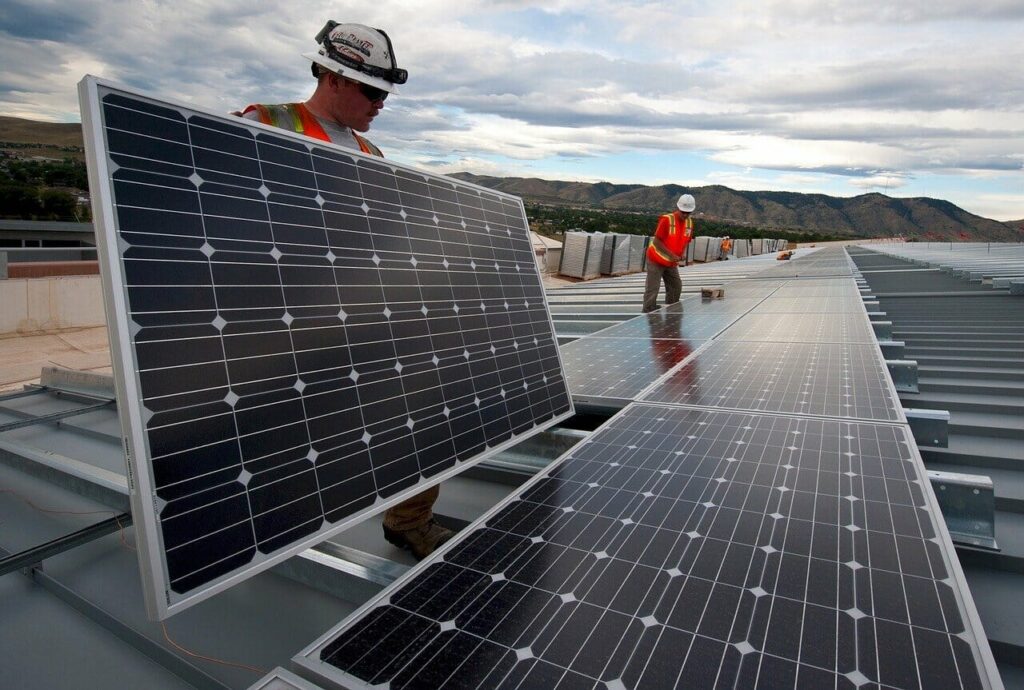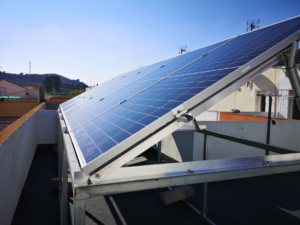El Gobierno aprueba 1.320 millones de euros en subvenciones para placas solares, baterías y climatización renovable.
Los programas contarán con un presupuesto inicial de 660 millones de euros ampliables hasta 1.320 millones a medida que las comunidades autónomas agoten sus asignaciones iniciales
Las ayudas se articularán en seis programas que repartirán un máximo de 900 millones para autoconsumo, 220 para almacenamiento detrás del contador y 200 para climatización y agua caliente con renovables
Estas actuaciones permitirán construir 1.850 MW renovables, incluyendo calefacción y refrigeración en más de 40.000 viviendas
Se crearán más de 25.000 empleos, el PIB crecerá en más de 1,7 millones por cada millón de ayuda y las emisiones de CO2 bajarán más de un millón de toneladas al año
El Consejo de Ministros, a propuesta del Ministerio para la Transición Ecológica y el Reto Demográfico (MITECO), ha aprobado un Real Decreto para conceder 660 millones de euros, ampliables a 1.320 millones, en subvenciones para instalaciones de autoconsumo (hasta 900 millones), almacenamiento detrás del contador con baterías (hasta 220 millones) y climatización con energías renovables (hasta 200 millones). Las comunidades y ciudades autónomas los diseminarán por todo el territorio nacional hasta 2023, de acuerdo con criterios transparentes y objetivos y permitirán crear más de 25.000 puestos de trabajo, entre directos e indirectos. Los beneficiarios de municipios con menos de 5.000 habitantes obtendrán un 10% adicional en su asignación.
Estos programas, con cargo al presupuesto del Plan de Recuperación, Transformación y Resiliencia, son las primeras líneas a gran escala a nivel estatal dirigidas específicamente a autoconsumo y almacenamiento. Se han consensuado con las comunidades y ciudades autónomas en la Conferencia Sectorial de Energía del pasado 12 de mayo. El Instituto para la Diversificación y el Ahorro de la Energía (IDAE) se encargará de coordinar las actuaciones y de hacer un seguimiento de su evolución, de acuerdo con el procedimiento usado exitosamente desde 2019.
Los 660 millones inicialmente presupuestados se ampliarán, según se vayan ejecutando las cuantías iniciales asignadas a cada Comunidad Autónoma, hasta alcanzar los 1.320 millones del programa total; las comunidades y ciudades autónomas deberán comprometer un 80% del presupuesto inicial durante el primer año o tendrán que reintegrar la mitad de lo no comprometido en el plazo de 15 meses desde la publicación en el BOE de este Real Decreto.
Las ayudas fomentarán la creación de empleo de proximidad y la mejora de la competitividad de empresas y economías domésticas al reducir sus costes energéticos. También contribuirán a alcanzar los objetivos en materia de energías limpias y de reducción de emisiones marcados por España, cuyo Plan Nacional Integrado de Energía y Clima (PNIEC) prevé una presencia de renovables sobre el uso final de energía del 42% en 2030. En el caso eléctrico, la generación limpia se combinará con 6 GW de potencia de almacenamiento para facilitar la gestión del sistema eléctrico. Por la vertiente térmica, la penetración del 18,9% en los suministros de calor y frío de 2019 debería duplicarse al final de la presente década.
Los 660 millones, con una estimación conservadora, permitirán construir 1.850 MW de generación renovable, incluyendo la sustitución de combustibles fósiles por energía renovable en calefacción y refrigeración en más de 40.000 viviendas. Igualmente, generarán más de 25.000 empleos directos e indirectos, superando los 45.000 puestos de trabajo al incluir también los inducidos; el PIB crecerá de 1,7 a 3,2 millones por cada millón de euros de ayuda materializada. Además, las instalaciones que se ejecuten reducirán las emisiones de CO2 en más de un millón de toneladas anuales y, al estar en áreas habitadas, reducirán los impactos en zonas sin actividad humana.
Seis programas de ayudas para instalar placas solares
Este paquete de ayudas se articulará por medio de seis programas. Los tres primeros están dirigidos a sectores económicos concretos, a partir de los datos del Instituto Nacional de Estadística (INE) de 2019, previos al estallido de la pandemia, mientras que los tres últimos, dirigidos sobre todo a viviendas, toman como referencia el número de viviendas principales u hogares, también según datos del INE.
Es importante señalar que el reparto del presupuesto entre las Comunidades Autónomas y las ciudades de Ceuta y Melilla es únicamente para la dotación inicial del programa. Para futuras ampliaciones de crédito, se tendrá en cuenta la ejecución del presupuesto y la demanda existente en cada territorio.
· Programa 1. Autoconsumo y almacenamiento en el sector servicios. Dotado con 120 millones (20 millones para almacenamiento).
· Programa 2. Autoconsumo y almacenamiento en otros sectores productivos, como la industria o el agropecuario. Dotado con 175 millones (25 millones para almacenamiento).
· Programa 3. Incorporación de almacenamiento en autoconsumos existentes en sectores económicos. Repartirá 45 millones entre las Comunidades Autónomas y las ciudades de Ceuta y Melilla.
· Programa 4. Autoconsumo y almacenamiento en el sector residencial, el sector público y el tercer sector. Con una dotación de 215 millones (15 millones para almacenamiento.
· Programa 5. Incorporación de almacenamiento en autoconsumos del sector residencial, sector público y tercer sector, con cinco millones presupuestados.
· Programa 6. Climatización y agua caliente sanitaria obtenida con renovables en el sector residencial, incluida la vivienda pública protegida. Contará con 100 millones.
Se podrá subvencionar la inversión en equipos y materiales; la obra civil; los equipamientos electromecánicos, hidráulicos, de control y auxiliares; los sistemas de gestión y monitorización, la redacción de proyectos, memorias técnicas y dirección facultativa, entre otras actuaciones.
Al objeto de facilitar el impacto de las ayudas sobre el tejido productivo nacional y orientarlas hacia la mejora ambiental, todas las actuaciones superiores a los 100 kW deberán incluir un plan estratégico de carácter público que indique el origen y el lugar de fabricación de los equipos y su efecto tractor sobre pymes y autónomos. El plan también detallará información sobre el criterio para seleccionar equipos y materiales en función de su impacto ambiental y su durabilidad –como las garantías del fabricante– y una justificación de que cumplen el principio europeo de no causar un daño significativo.
Por otro lado, para aumentar la información y la sensibilización de la sociedad, todas las instalaciones subvencionadas tendrán que incluir un sistema de monitorización. En empresas y administraciones, su rendimiento deberá reflejarse en una pantalla a la vista del público o los trabajadores; en viviendas será accesible mediante un dispositivo móvil.
Cuantía de las subvenciones para autoconsumo, baterías y climatización renovable
La intensidad de las subvenciones al autoconsumo, el almacenamiento de energía en baterías y la climatización renovables variará en función del beneficiario y del tipo de instalación. Para las empresas se asignará un porcentaje sobre el volumen de inversión inicial –hasta un máximo–, mientras que para los particulares y las administraciones públicas se subvencionará un porcentaje fijo.
En el caso de la energía solar fotovoltaica las ayudas abarcarán desde el 15% para una gran empresa hasta el 45% para una pyme o un sistema pequeño, inferior a 10 kW; los particulares podrán beneficiarse de un 40% –sube al 50% en los sistemas de autoconsumo colectivo– y las administraciones públicas del 70%. Se valorará la retirada de cubiertas de amianto y la instalación de marquesinas para optimizar el uso del espacio, como es frecuente en aparcamientos.
En el caso de la eólica, la subvención oscilará entre el 20% para la instalación más grande en grandes empresas y el 50% en los sistemas más pequeños para pymes; los particulares obtendrán un 50% y las administraciones públicas un 70%.
En las instalaciones de almacenamiento detrás del contador, que en general serán baterías, las ayudas para las empresas variarán entre el 45% y el 65%, dependiendo del tamaño de la organización, mientras que los particulares, administraciones y entidades del tercer sector podrán beneficiarse de un 70%.
En climatización con renovables, la subvención dependerá de la tecnología empleada –como la biomasa o la geotermia–, y será del 40% al 70%. Las Administraciones públicas propietarias de edificios residenciales podrán obtener un 70%.

Subvenciones para placas solares en pueblos y pequeñas ciudades
Con el objeto de afrontar el reto demográfico, todos los conceptos anteriores se incrementarán en un 5% adicional en aquellos municipios con menos de 5.000 habitantes y en los municipios con menos de 20.000 habitantes en entornos rurales cuyos diferentes núcleos de población tengan menos de 5.000 habitantes
Las líneas de ayudas para particulares, autónomos y administraciones públicas entrarán en vigor al día siguiente de la publicación en el BOE del Real Decreto. Los destinatarios de las ayudas tendrán un plazo de 18 meses para justificar la construcción de las instalaciones desde el momento en que se les notifique su concesión.
Fuente: MITECO





